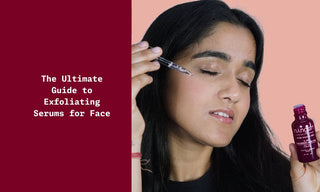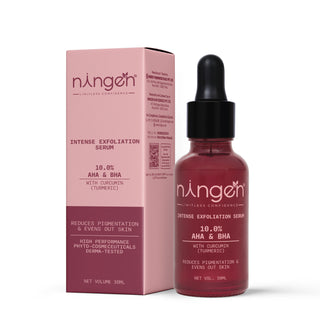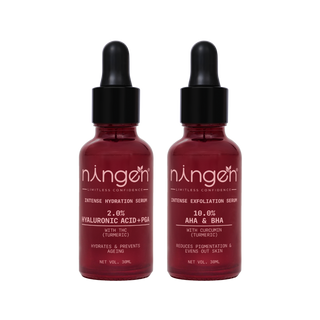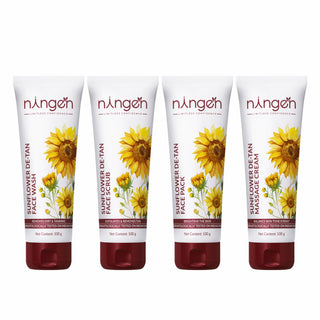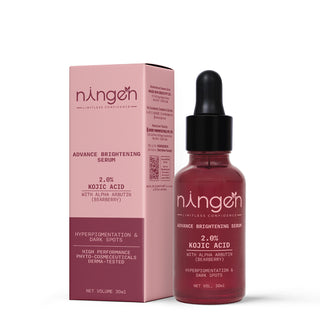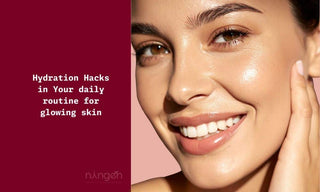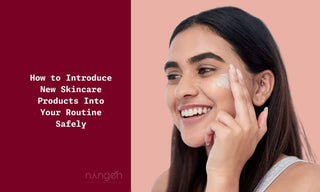Do you know?
Your skin naturally sheds around 30,000 to 40,000 dead cells every minute, but exfoliation helps speed up this process for a brighter, smoother complexion!
In a world where skincare is a prominent aspect of self-care, exfoliating serums have emerged as a game changer. These powerful products promise to revitalize the skin, combat aging, and enhance overall texture, making them essential for those seeking a radiant complexion.
This guide is your Ultimate guide to exfoliating serums for the face, explaining the various types of exfoliating serums, their benefits, and how to choose and use them safely within your skincare routine providing the comprehensive insights you need for glowing skin.
Inside This Guide:
What are the Benefits of Using Exfoliating Serums?
How to Choose the Right Exfoliating Serum for Your Skin Type?
How to Use Exfoliation Serum For the Face?
How to Safely Use Exfoliating Serums?
When to Use Exfoliating Serums?
How Does Exfoliating Serum Works?
Why Layering Hydrating Serums is Vital with Exfoliating Serum?
TL;DR (Too Long; Didn't Read):
What Are Exfoliating Serums?
Exfoliating serums are powerful skincare products that help you get a brighter, smoother complexion by clearing away dead skin cells and encouraging fresh, new skin to appear. They usually contain ingredients like glycolic acid, salicylic acid, and lactic acid, which gently dissolve dead skin to reveal a healthy glow.
They use special ingredients like glycolic or salicylic acid to break down and remove dead skin cells. This helps unclog pores, smooth rough skin, and reveal a fresher, brighter complexion. Regular use can improve skin texture and make it look healthier and more radiant!
What are the Benefits of Using Exfoliating Serums?
-
Improved Skin Texture: Exfoliating serums help remove dead skin cells from the surface, leading to smoother and more refined skin texture, making it feel softer and more youthful.
-
Enhanced Radiance: By promoting cell turnover and removing dull, lifeless skin, exfoliating serums can give the skin a vibrant and radiant appearance, highlighting a natural glow.
-
Minimized Pore Appearance: Exfoliating serums can help clear out clogged pores and reduce their visibility, resulting in a more even complexion and fewer breakouts.
-
Faded Dark Spots and Hyperpigmentation: Many exfoliating serums contain ingredients that can help fade dark spots, sun damage, and hyperpigmentation, leading to a more uniform skin tone.
-
Increased Absorption of Other Products: Exfoliating serums can enhance the absorption of other skincare products (like moisturizers and treatments) by ensuring that the skin is free from the buildup of dead skin cells.
-
Boosted Collagen Production: Some exfoliating serums stimulate collagen production, which can help in reducing the appearance of fine lines and wrinkles, contributing to firmer, more youthful-looking skin.
-
Acne Prevention: By keeping pores clean and free from dead skin cells, exfoliating serums can help reduce the occurrence of breakouts, making them beneficial for those with acne-prone skin.
-
Balanced Oil Production: Exfoliation can regulate oil production in the skin, which is particularly beneficial for individuals with oily or combination skin types.
-
Customized Formulations: Many exfoliating serums come in various formulations, allowing individuals to choose products tailored to their specific skin types and concerns, be it sensitive skin, aging skin, or acne-prone skin.
-
Convenient and Easy to Use: Exfoliating serums are typically easy to integrate into any skincare routine, making it simple to achieve the benefits of regular exfoliation without extensive time or effort required.
Types of Exfoliating Serums
Exfoliating serums are essential to a comprehensive skincare routine, designed to remove dead skin cells and promote a clearer, more radiant complexion. There are several types of exfoliating serums, each with unique active ingredients that target different skin concerns. Understanding these types can help you select the best one for your skin type and needs. The primary categories of exfoliating serums include AHA, BHA, and PHA.
AHA (Alpha Hydroxy Acids) Overview
Alpha Hydroxy Acids, or AHAs, are water-soluble acids derived from fruits like grapes and citrus. They are effective for exfoliating the skin's surface, making them ideal for individuals with dry skin or those looking to improve uneven skin tone. AHAs work by gently dissolving the bonds that hold dead cells together, promoting faster cell turnover and revealing fresher skin underneath.
Benefits of AHA Serums:
-
Improves skin texture and reduces fine lines.
-
Effective for managing pigmentation issues and dark spots.
-
Enhances overall skin radiance and glow.
Common AHAs used in skincare include glycolic acid and lactic acid. These ingredients are popular in anti-aging serums and are known for boosting collagen production, resulting in firmer, smoother skin.
BHA (Beta Hydroxy Acids) Overview
Beta Hydroxy Acids, commonly salicylic acid, are oil-soluble and are best suited for oily and acne-prone skin. BHAs penetrate deep into pores to exfoliate from within, making them effective for reducing blackheads, whiteheads, and other forms of acne.
BHA Serum Benefits:
-
Unclogs pores and reduces acne.
-
Refines large pores and improves skin texture.
-
Helps in reducing redness and inflammation associated with breakouts.
Because BHAs are adept at controlling oil production, they are an excellent choice for those with combination or oily skin types, seeking clearer and more balanced skin.
PHA (Polyhydroxy Acids) Overview
Polyhydroxy Acids are the gentlest form of exfoliating acids, featuring larger molecular structures that limit their penetration into the skin, reducing potential irritation. PHAs are perfect for those with sensitive skin or conditions like rosacea and eczema.
Benefits of PHA Serums:
-
Provides mild exfoliation with minimal irritation.
-
Offers additional hydration benefits.
-
Antioxidant properties help protect the skin from environmental damage.
PHAs like gluconolactone and lactobionic acid not only exfoliate but also hydrate, making them suitable for maintaining a healthy moisture barrier while achieving a smoother, brighter complexion.

How to Choose the Right Exfoliating Serum for Your Skin Type?
In choosing the best exfoliating serum for your face, consider your skin type and concerns. Whether dealing with dryness, sensitivity, or oiliness, there's an exfoliating serum designed to meet your skincare needs effectively.
Dry Skin Considerations
When dealing with dry skin, it is essential to choose an exfoliating serum that hydrates while exfoliating. Look for serums containing lactic acid, a milder chemical exfoliant, which helps retain moisture while gently sloughing off dead skin cells.
-
Opt for formulations with hydrating ingredients like Hyaluronic acid or glycerin.
-
A combination of a low concentration of AHA (alpha hydroxy acids) in such exfoliating serums can contribute to a smoother, moisture-rich skin.
-
Avoid high concentrations of exfoliants, as they can strip the skin's natural oils, exacerbating dryness.
Oily Skin Considerations
For oily or acne-prone skin, salicylic acid exfoliating serums can be particularly beneficial. As a BHA (beta hydroxy acid), salicylic acid penetrates deep into the pores to remove excess oil and dead cells, reducing breakouts and blackheads.
-
BHAs are oil-soluble, making them ideal for controlling oil and reducing acne.
-
Consider serums with niacinamide, which can help regulate sebum production and improve skin texture.
-
Regular use of a BHA serum can leave your skin less greasy and more balanced.
Combination Skin Considerations
Combination skin can be tricky, as it involves areas that are oily and others that are dry. Look for a balanced exfoliating serum that caters to multiple skin concerns.
-
Choose serums that contain both AHA and BHA to target different areas of your face.
-
Focus on a lightweight formula that won’t overpower your skin’s natural balance.
-
While applying, choose to selectively exfoliate T-zone areas more frequently.
Sensitive Skin Considerations
Sensitive skin requires delicate care with skincare products to avoid irritation and redness. An exfoliating serum with gentle active ingredients is preferred.
-
Lactic acid serums or those containing PHA (polyhydroxy acids) are less irritating and more suitable for delicate skin.
-
Incorporate anti-inflammatory ingredients like allantoin or chamomile extract to soothe the skin while exfoliating.
-
Patch-test new products and introduce them gradually into your skincare regimen to ensure compatibility.
Comparison Table: Exfoliating Serums for Different Skin Types

How to Use Exfoliation Serum For the Face?
The following is a step-by-step guide on how to use exfoliation serum. Have a look.
-
Choose the Right Exfoliation Serum: Select an exfoliation serum that is suitable for your skin type—whether it be glycolic acid, salicylic acid, or another exfoliating ingredient as we have already mentioned.
-
Cleanse Your Face: Before applying the serum, wash your face with a gentle cleanser to remove makeup, dirt, and oil, creating a clean surface for the treatment.
-
Pat Dry: Gently pat your face dry with a clean towel. It's essential not to rub the skin harshly to avoid irritation.
-
Apply a Small Amount: Dispense a few drops of the exfoliation serum onto your fingertips or a cotton pad. A little goes a long way; you don't need to use an excessive amount.
-
Pat & press; do not rub: Gently apply the serum evenly across your face and neck by pat & press method. Be careful to avoid the eye area, as it is more sensitive.
-
Allow Absorption: Let the serum absorb into your skin for a few minutes before applying any other products. This will allow the active ingredients to penetrate effectively.
-
Follow with Moisturizer: After the serum has been absorbed, moisturize to lock in moisture and counteract any further dryness.
-
Use Sunscreen: If using the exfoliating serum in the morning, it is crucial to apply sunscreen afterward, as exfoliated skin can be more sensitive to UV rays.
-
Start Slowly: If you are new to exfoliation, start by using the serum once or twice a week and gradually increase usage as your skin builds tolerance.
-
Monitor Skin Reaction: Always pay attention to your skin's reaction. If you experience excessive redness, irritation, or discomfort, reduce the frequency of use or consult a dermatologist.
-
Store Properly: Keep the serum in a cool, dry place away from direct sunlight to maintain its effectiveness and shelf life.
-
Pro tip: if you have dry skin or very dry skin or dryness with sensitivity, must apply a hydrating serum after cleansing and then apply the exfoliating serum.
By following these steps, you can effectively use exfoliation serum for a clearer, smoother complexion.
How to Safely Use Exfoliating Serums?
1️⃣ Start Slow – Use 2-3 times a week to see how your skin reacts.
2️⃣ Apply a Few Drops – Gently spread a thin layer over your face, avoiding the eye area.
3️⃣ Use Sunscreen – Exfoliation makes skin sensitive to the sun, so SPF is a must!
4️⃣ Don’t Overdo It – Too much can cause irritation; stick to recommended usage.
5️⃣ Avoid Mixing Harsh Actives – Don’t use with strong retinoids or vitamin C at the same time.
Recommended Frequency of Use

When to Use Exfoliating Serums?
Exfoliating serums can be used both morning and evening but they are best used at night as they can make your skin sensitive to UV rays. This also allows for deeper penetration as your skin regenerates overnight.
What is the Age to Start with Exfoliation Serum?
Exfoliation serum can be started as early as your teenage years if you have uneven skin tone or if a dermatologist recommends it. With puberty, your skin starts producing more oil and dead skin cells, making exfoliation even more beneficial.
Alternatively, if your skin is normal, you can begin a little late like at the age of 25 or so. Regardless, exfoliating the skin once or twice a week is essential for a clear, glowing complexion.
How to Use Exfoliation Serums if You Have Sensitive Skin?
Many people with sensitive skin avoid exfoliating, fearing irritation and redness. However, using the best exfoliating serum for sensitive skin can enhance the skin's texture without causing harm. If your skin is sensitive, follow these tips while using exfoliating serums:
-
Opting for milder active ingredients like lactic acid or polyhydroxy acids.
-
Always start slowly, introducing the serum once or twice a week, and gradually increase frequency as tolerated.
-
Additionally, pairing an exfoliating serum with a hydrating serum can prevent dryness or sensitivity. Apply a hydrating serum first, then go for the exfoliation serum.
-
Always wear SPF when exposed to UV rays, because sensitivity may increase with UV rays.

How Does Exfoliating Serum Works?
Exfoliation serums work by utilizing various active ingredients to remove dead skin cells, promote cell turnover, and improve overall skin texture and appearance. Here’s how the skin changes over days and weeks with regular use of an exfoliation serum:
-
Immediate Effects (Day 1-3): After the first application, the serum starts to dissolve the outer layer of dead skin cells. This can lead to an immediate improvement in skin texture, making it feel smoother and more radiant. Sometimes, in this stage, your skin may look a little dry or dull as the dead skin starts accumulating on the surface. Do not worry, it will disappear with regular cleansing.
-
Initial Brightness (Day 4-7): As the dead skin cells are removed, the underlying fresh skin is revealed, resulting in a brighter complexion. You may notice a reduction in dullness and an overall glow.
-
Improved Absorption (Week 1): With the outer layer of dead skin cells sloughed away, other skincare products (like moisturizers and serums) can penetrate more effectively, enhancing their efficacy.
-
Reduced Appearance of Pores (Week 2): Regular exfoliation can help to unclog pores, leading to a decrease in the appearance of enlarged pores. The skin may appear smoother as texture irregularities are minimized.
-
Diminished Fine Lines (Week 3): Continued use of exfoliation serums can stimulate collagen production, resulting in the reduction of fine lines and wrinkles over time. The skin begins to look firmer and more youthful.
-
Even Skin Tone (Week 4 and Beyond): As cell turnover increases, dark spots, hyperpigmentation, and uneven skin tone may begin to fade. The overall complexion appears more uniform.
-
Improved Overall Texture (After 4 Weeks): With prolonged use, the skin texture continues to improve. The serum helps to refine and smooth the skin surface, leading to a more polished appearance.
-
Enhanced Hydration (After 4-6 Weeks): Maintaining proper hydration alongside exfoliation can lead to plumper skin. Exfoliation helps to remove barriers that prevent moisture from penetrating the skin.
-
Long-term Benefits (2 Months and Beyond): Over time, ongoing use of an exfoliation serum can significantly enhance skin clarity and reduce breakouts by preventing clogged pores, leading to a healthier complexion.
Customized Results: The positive changes may vary depending on skin type and the specific ingredients in the serum. Regular adjustments based on skin needs can help maximize results while minimizing irritation.
Why Layering Hydrating Serums is Vital with Exfoliating Serum?
Layering hydrating serums with exfoliating serums is crucial to achieving a balanced and radiant complexion. Exfoliating serums, often containing active ingredients like salicylic acid and glycolic acid, work by removing dead skin cells and improving skin texture. However, they can sometimes leave the skin feeling dry or irritated, especially in sensitive or dry skin types.
- Benefits of Layering:
-
Hydration Boost: Hydrating serums infused with hyaluronic acid can restore moisture, keeping skin plump and supple.
-
Barrier Protection: These serums help rebuild the skin’s natural barrier, which can be compromised by the potent action of exfoliating serums.
-
Improved Efficacy: With hydrated skin, exfoliating serums can penetrate more effectively, enhancing their ability to treat concerns like dark spots or uneven skin tone.
- Application Tip for normal skin:
-
Apply the exfoliating serum to clean skin.
-
Follow with a hydrating serum to lock in moisture.
- Application Tip for dry skin:
-
Apply the hydrating serum to hydrate the skin.
-
Apply exfoliation serum on top of it.
- Follow up with a moisturizer.

Ningen Blemishfix Duo: A combo of hydration & exfoliation
Final Insights
This comprehensive guide has efficiently provided vital information on exfoliating serums for the face, consolidating everything you need to know into one convenient article. From understanding the benefits of salicylic acid exfoliating serums to exploring various active ingredients like glycolic acid and lactic acid, this guide covers a wide range of skin concerns and types, whether oily, dry, or sensitive.
The guide also highlights the importance of incorporating chemical exfoliants like AHA and BHA serums into your skincare routine to address dead skin cells, uneven skin tone, and acne-prone issues. It also touches on specialized products like exfoliating night and hydrating serums for tailored skincare regimens.
Here's a quick look at some key elements:
-
Active Ingredients: Salicylic acid, Glycolic acid, Lactic acid
-
Skin Concerns: Dark spots, Sensitive skin, Oily skin
-
Benefits: Improved skin texture, Radiant and brighter complexion, Enhanced collagen production
We value your opinion! Please share your thoughts on this blog and any additional insights you might have for fellow readers. Your feedback not only enhances our content but also helps others navigate their skincare journey more effectively.
TL;DR (Too Long; Didn't Read):
This article is an exclusive guide for exfoliation serums. Exfoliating serums are essential for achieving a smoother, brighter complexion by removing dead skin cells and promoting fresh skin. They contain active ingredients like AHA (glycolic/lactic acid), BHA (salicylic acid), and PHA for exfoliation. The benefits include improved skin texture, reduced fine lines, minimized pores, enhanced radiance, and better absorption of other skincare products. Choose the right serum based on your skin type (dry, oily, sensitive) and concerns. Start slow, use sunscreen, and follow with hydrating products to keep skin balanced and glowing. Check out this article to clear up any confusion about exfoliating serums, complete with pro- tips!
Frequently Asked Questions
-
What is an exfoliating serum for the face? An exfoliating serum is a skincare product designed to remove dead skin cells, revealing smoother, brighter skin. It contains active ingredients like AHA, BHA, or PHA that help promote cell turnover and improve skin texture.
-
What are the benefits of using an exfoliating serum for the face? Exfoliating serums improve skin texture, reduce fine lines, fade dark spots, minimize pores, boost collagen production, and enhance absorption of other skincare products for a radiant complexion.
-
What is the best exfoliating serum for sensitive skin? For sensitive skin, look for serums with gentler exfoliants like lactic acid or polyhydroxy acids (PHA). These provide effective exfoliation without causing irritation.
-
How often should I use an exfoliating serum? Start using your exfoliating serum 2-3 times a week. Gradually increase the frequency based on how your skin reacts. Always use sunscreen after exfoliating, as your skin will be more sensitive to UV rays.
-
What is the difference between AHA and BHA exfoliating serums? AHA (Alpha Hydroxy Acid) is water-soluble and great for dry, uneven skin. BHA (Beta Hydroxy Acid), like salicylic acid, is oil-soluble and works best for oily, acne-prone skin, as it penetrates deeper into pores.
-
Can I use an exfoliating serum every day? It's best to start slowly. Use an exfoliating serum 2-3 times a week to see how your skin reacts. If you have sensitive skin, don’t use it daily unless advised by a dermatologist.
-
Can exfoliating serums help with acne? Yes! Exfoliating serums with BHA (salicylic acid) are particularly effective for acne-prone skin, as they unclog pores and reduce breakouts by removing dead skin and excess oil.
-
Should I use an exfoliating serum in the morning or at night? Exfoliating serums are most effective at night, as they can make your skin more sensitive to sunlight. Use it before bed, allowing your skin to regenerate overnight.
-
How do I layer exfoliating serums into my skincare routine? Cleanse your face, apply a few drops of exfoliating serum, wait for it to absorb, then follow with moisturizer. If using in the morning, always apply sunscreen afterward.
-
What is the best exfoliating serum for glowing skin? The best exfoliating serum for glowing skin would be one that includes AHA ingredients like glycolic or lactic acid, which improve skin texture and radiance, helping you achieve a smooth, glowing complexion.


